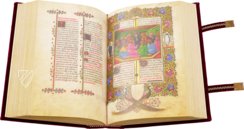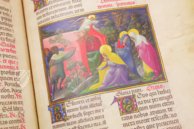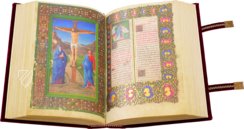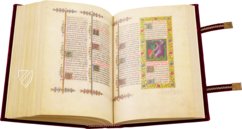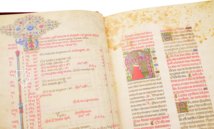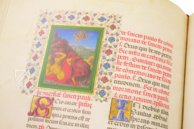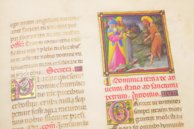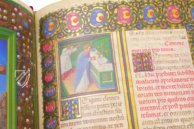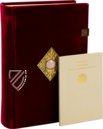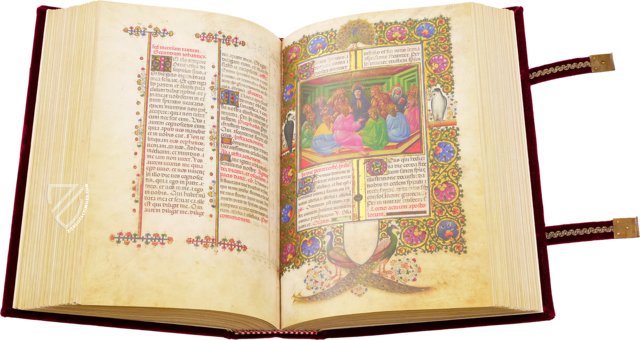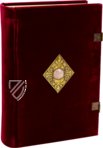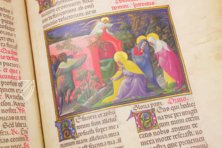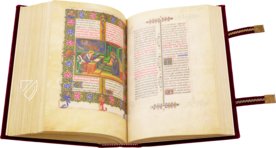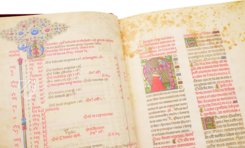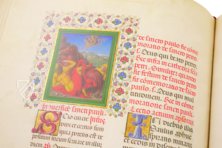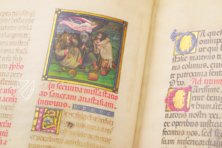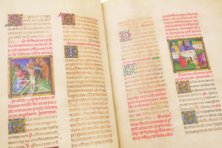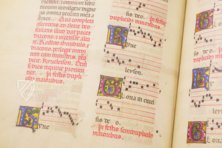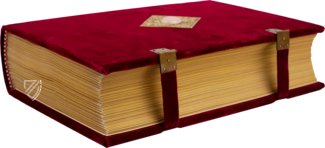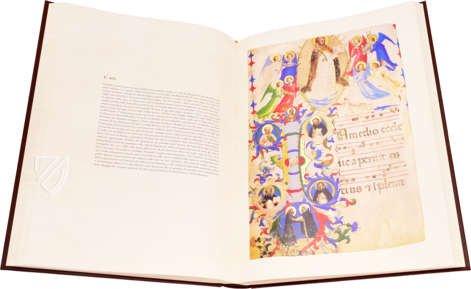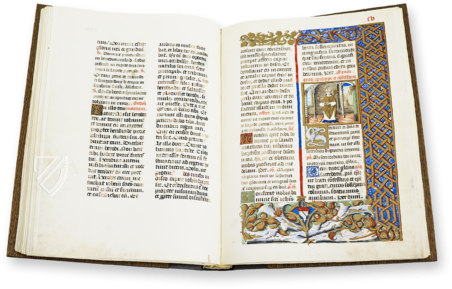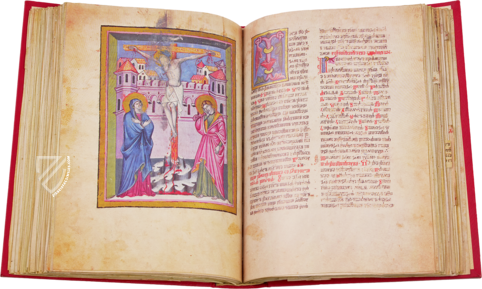Missal of Barbara of Brandenburg
(3,000€ - 7,000€)
The Missale of Barbara of Brandenburg is one of the most beautiful liturgical manuscripts of the Middle Ages. The precious manuscript was designed and decorated between 1442 and 1465 by some of the most famous illuminators of the Middle Ages. Among the artists involved are Belbello da Pavia, Girolamo da Cremona and most likely Rogier van der Weyden. The masterpiece is magnificently decorated with 70 larger and smaller miniatures and countless additional decorative elements of gold leaf and lapis lazuli. Originally commissioned by Gianlucido Gonzaga, it remained unfinished when he died in 1448. As one of the most remarkable and cultivated women of the Renaissance, Barbara of Brandenburg recognized the unbelievable worth of the enchantingly illuminated masterpiece and had work on the manuscript continued a year later. Completed in 1465, the manuscript is today considered one of the most important representatives of late Gothic illumination.
Missal of Barbara of Brandenburg
The Italian painter and illuminator Belbello da Pavia began work in the year 1442 on a manuscript, which belongs today among the most exciting and precious codices of the Middle Ages. The Missal of Barbara of Brandenburg was manufactured over 20+ years through the collaboration of some of the greatest masters of the late Gothic and Renaissance styles. The splendid work contains 70 full-page, breathtaking miniatures. The 12 text pages presenting a calendar are particularly beautiful and elaborate. The handwritten text of the work is embellished with over 2,000 fantastically illuminated initials of various sizes.
The Countess Barbara von Brandenburg
Barbara von Brandenburg was the oldest child of Margrave Johann von Brandenburg and his wife Barbara, a daughter of Rudolf II von Sachsen-Wittenberg. She was already married to Margrave Luigi III Gonzaga von Mantua at the tender age of 11. The young Marquis grew up at the court of Mantua together with other members of the Gonzaga family and developed into one of the most remarkable and cultivated women of the Renaissance. She could speak four languages fluently and was a great patron of art and literature. The astounding Missal of Barbara of Brandenburg was originally created at the behest of Gianlucido Gonzaga (1421–48). He commissioned Belbello da Pavia with the design of the work. When he died in 1448, Barbara had already long recognized the unbelievable worth of the enchantingly illuminated masterpiece. She had work on the manuscript continued a year later.
Europe’s Greatest Artists
Belbello da Pavia, who began with the design of the missal in 1442, is considered today to be the most important representative of late-Gothic illumination. Together with the calligrapher Pietro Paolo Marono, who also composed the text of the famous Bible of Borso d’Este, produced a stunningly beautiful liturgical book, which remained unfinished for nearly a decade after da Pavia’s death. Girolamo da Cremona completed the precious manuscript in the year 1465 and with his pictures, allowed da Pavia’s enchanting, late Gothic depictions to meet with the new stylistic elements of the Renaissance. All of the miniatures were painted in powerful colors and are extraordinarily richly furnished with gold leaf and lapis lazuli. Three of the high-quality pictures originate from an anonymous artist, who in the field of art-historical research is considered very likely to be Rogier van der Weyden.
Codicology
- Alternative Titles
- Messale di Barbara del Brandeburgo
Missale der Barbara von Brandenburg - Size / Format
- 760 pages / 39.5 × 26.0 cm
- Origin
- Italy
- Date
- 1442–1465
- Epochs
- Style
- Genre
- Language
- Script
- Humanistic minuscule
- Illustrations
- 12 pages calendar with ornaments along the external margins. The following 68 miniatures include 2 big initials, 7 ff. with decorations all around the text, more than 2,000 illuminated capital letters of different size and hundreds of ink-decorated paragraph initials
- Content
- Missal with the ordo missae and the prayers for the celebration of the Eucharist
- Patron
- Gianlucido Gonzaga (1421–48); Barbara of Brandenburg (1422–81)
- Artist / School
- Andrea Mantegna (ca. 1431–1506) (scribe)
Pietro Paolo Marono (scribe)
Belbello da Pavia (d. ca. 1470) (illuminator)
Girolamo da Cremona (fl. 1451–83) (illuminator)
Rogier van der Weyden (1399/1400–1464) (illuminator)
Taddeo Crivelli (d. 1479) (illuminator) - Previous Owners
- Cardinal Ercole Gonzaga (1505–63)
Mantua Cathedral
Missal of Barbara of Brandenburg
Acanthus Frame with Crossed Peacocks
The true mark of an Italian Renaissance masterpiece is that its marginalia and text are created with the same artistic quality and precious materials as its miniatures and historiated initials. Found on the page dedicated to the Pentecost, we see two peacocks – symbols of royalty – with magnificently illuminated plumage, their long crossed tales sparkling. The acanthus leaf, a popular Roman piece of décor, is featured prominently in the golden frame that surrounds the perfectly written text.
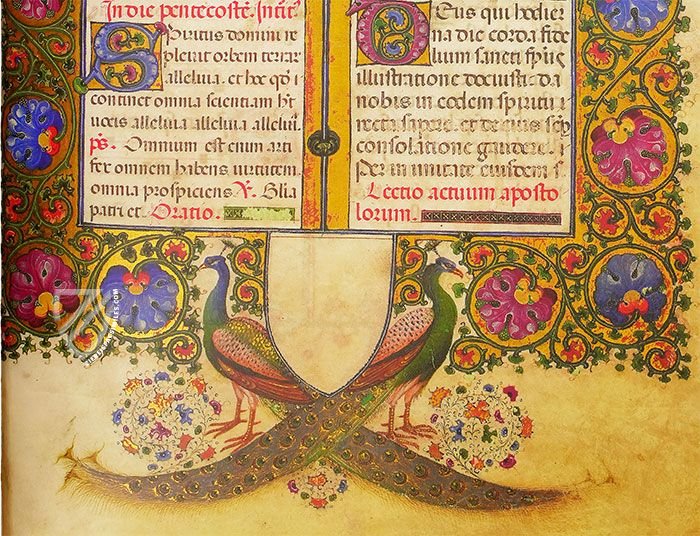
Missal of Barbara of Brandenburg
Crucifixion
The most iconic of Christian images is presented here in a miniature by the Italian Renaissance master Girolamo da Cremona. Christ is depicted in a monumental manner reminiscent of early Byzantine art: he is dead but not in pain and seems to stand rather than hang from the cross. The Virgin Mary and St. John the Evangelist flank him, as is typical of late medieval Crucifixion scenes, and have looks of wonder rather than of sorrow.
A wonderful cityscape of Jerusalem is depicted in the background with other settlements visible in the distance under a clear blue sky. The scene is set within a gorgeous illusionistic frame depicted as golden jewelry with pearls, precious stones, and two small angels. Finally, one cannot help but notice the perfect symmetry of the scene.

#1 Messale di Barbara del Brandeburgo (Deluxe Edition)
Language: Italian
(3,000€ - 7,000€)
#2 Messale di Barbara del Brandeburgo (Standard Edition)
Language: Italian
(over 10,000€)
- Treatises / Secular Books
- Apocalypses / Beatus
- Astronomy / Astrology
- Bestiaries
- Bibles / Gospels
- Chronicles / History / Law
- Geography / Maps
- Saints' Lives
- Islam / Oriental
- Judaism / Hebrew
- Single Leaf Collections
- Leonardo da Vinci
- Literature / Poetry
- Liturgical Manuscripts
- Medicine / Botany / Alchemy
- Music
- Mythology / Prophecies
- Psalters
- Other Religious Books
- Games / Hunting
- Private Devotion Books
- Other Genres
- Afghanistan
- Armenia
- Austria
- Belgium
- Belize
- Bosnia and Herzegovina
- China
- Colombia
- Costa Rica
- Croatia
- Cyprus
- Czech Republic
- Denmark
- Egypt
- El Salvador
- Ethiopia
- France
- Germany
- Greece
- Guatemala
- Honduras
- Hungary
- India
- Iran
- Iraq
- Israel
- Italy
- Japan
- Jordan
- Kazakhstan
- Kyrgyzstan
- Lebanon
- Liechtenstein
- Luxembourg
- Mexico
- Morocco
- Netherlands
- Palestine
- Panama
- Peru
- Poland
- Portugal
- Romania
- Russia
- Serbia
- Spain
- Sri Lanka
- Sweden
- Switzerland
- Syria
- Tajikistan
- Turkey
- Turkmenistan
- Ukraine
- United Kingdom
- United States
- Uzbekistan
- Vatican City
- A. Oosthoek, van Holkema & Warendorf
- Aboca Museum
- Ajuntament de Valencia
- Akademie Verlag
- Akademische Druck- u. Verlagsanstalt (ADEVA)
- Aldo Ausilio Editore - Bottega d’Erasmo
- Alecto Historical Editions
- Alkuin Verlag
- Almqvist & Wiksell
- Amilcare Pizzi
- Andreas & Andreas Verlagsbuchhandlung
- Archa 90
- Archiv Verlag
- Archivi Edizioni
- Arnold Verlag
- ARS
- Ars Magna
- ArtCodex
- AyN Ediciones
- Azimuth Editions
- Badenia Verlag
- Bärenreiter-Verlag
- Belser Verlag
- Belser Verlag / WK Wertkontor
- Benziger Verlag
- Bernardinum Wydawnictwo
- BiblioGemma
- Biblioteca Apostolica Vaticana (Vaticanstadt, Vaticanstadt)
- Bibliotheca Palatina Faksimile Verlag
- Bibliotheca Rara
- Boydell & Brewer
- Bramante Edizioni
- Bredius Genootschap
- Brepols Publishers
- British Library
- C. Weckesser
- Caixa Catalunya
- Canesi
- CAPSA, Ars Scriptoria
- Caratzas Brothers, Publishers
- Carus Verlag
- Casamassima Libri
- Centrum Cartographie Verlag GmbH
- Chavane Verlag
- Christian Brandstätter Verlag
- Circulo Cientifico
- Club Bibliófilo Versol
- Club du Livre
- CM Editores
- Collegium Graphicum
- Collezione Apocrifa Da Vinci
- Comissão Nacional para as Comemorações dos Descobrimentos Portugueses
- Coron Verlag
- Corvina
- CTHS
- D. S. Brewer
- Damon
- De Agostini/UTET
- De Nederlandsche Boekhandel
- De Schutter
- Deuschle & Stemmle
- Deutscher Verlag für Kunstwissenschaft
- DIAMM
- Droz
- E. Schreiber Graphische Kunstanstalten
- Ediciones Boreal
- Ediciones Grial
- Ediclube
- Edições Inapa
- Edilan
- Editalia
- Edition Deuschle
- Edition Georg Popp
- Edition Leipzig
- Edition Libri Illustri
- Editiones Reales Sitios S. L.
- Éditions de l'Oiseau Lyre
- Editions Medicina Rara
- Editorial Casariego
- Editorial Mintzoa
- Editrice Antenore
- Editrice Velar
- Edizioni Edison
- Egeria, S.L.
- Eikon Editores
- Electa
- Emery Walker Limited
- Enciclopèdia Catalana
- Eos-Verlag
- Ephesus Publishing
- Ernst Battenberg
- Eugrammia Press
- Extraordinary Editions
- Fackelverlag
- Facsimila Art & Edition
- Facsimile Editions Ltd.
- Facsimilia Art & Edition Ebert KG
- Faksimile Verlag
- Feuermann Verlag
- Folger Shakespeare Library
- Franco Cosimo Panini Editore
- Friedrich Wittig Verlag
- Fundación Hullera Vasco-Leonesa
- G. Braziller
- Gabriele Mazzotta Editore
- Gebr. Mann Verlag
- Gesellschaft für graphische Industrie
- Getty Research Institute
- Giovanni Domenico de Rossi
- Giunti Editore
- Graffiti
- Grafica European Center of Fine Arts
- Guido Pressler
- Guillermo Blazquez
- Gustav Kiepenheuer
- H. N. Abrams
- Harrassowitz
- Harvard University Press
- Helikon
- Hendrickson Publishers
- Henning Oppermann
- Herder Verlag
- Hes & De Graaf Publishers
- Hoepli
- Holbein-Verlag
- Houghton Library
- Hugo Schmidt Verlag
- Idion Verlag
- Il Bulino, edizioni d'arte
- ILte
- Imago
- Insel Verlag
- Insel-Verlag Anton Kippenberger
- Instituto de Estudios Altoaragoneses
- Instituto Nacional de Antropología e Historia
- Introligatornia Budnik Jerzy
- Istituto dell'Enciclopedia Italiana - Treccani
- Istituto Ellenico di Studi Bizantini e Postbizantini
- Istituto Geografico De Agostini
- Istituto Poligrafico e Zecca dello Stato
- Italarte Art Establishments
- Jan Thorbecke Verlag
- Johnson Reprint Corporation
- Josef Stocker
- Josef Stocker-Schmid
- Jugoslavija
- Karl W. Hiersemann
- Kasper Straube
- Kaydeda Ediciones
- Kindler Verlag / Coron Verlag
- Kodansha International Ltd.
- Konrad Kölbl Verlag
- Kurt Wolff Verlag
- La Liberia dello Stato
- La Linea Editrice
- La Meta Editore
- Lambert Schneider
- Landeskreditbank Baden-Württemberg
- Leo S. Olschki
- Les Incunables
- Liber Artis
- Library of Congress
- Libreria Musicale Italiana
- Lichtdruck
- Lito Immagine Editore
- Lumen Artis
- Lund Humphries
- M. Moleiro Editor
- Maison des Sciences de l'homme et de la société de Poitiers
- Manuscriptum
- Martinus Nijhoff
- Maruzen-Yushodo Co. Ltd.
- MASA
- Massada Publishers
- McGraw-Hill
- Metropolitan Museum of Art
- Militos
- Millennium Liber
- Müller & Schindler
- Nahar - Stavit
- Nahar and Steimatzky
- National Library of Wales
- Neri Pozza
- Nova Charta
- Oceanum Verlag
- Odeon
- Orbis Mediaevalis
- Orbis Pictus
- Österreichische Staatsdruckerei
- Oxford University Press
- Pageant Books
- Parzellers Buchverlag
- Patrimonio Ediciones
- Pattloch Verlag
- PIAF
- Pieper Verlag
- Plon-Nourrit et cie
- Poligrafiche Bolis
- Presses Universitaires de Strasbourg
- Prestel Verlag
- Princeton University Press
- Prisma Verlag
- Priuli & Verlucca, editori
- Pro Sport Verlag
- Propyläen Verlag
- Pytheas Books
- Quaternio Verlag Luzern
- Reales Sitios
- Recht-Verlag
- Reichert Verlag
- Reichsdruckerei
- Reprint Verlag
- Riehn & Reusch
- Roberto Vattori Editore
- Rosenkilde and Bagger
- Roxburghe Club
- Salerno Editrice
- Saltellus Press
- Sandoz
- Sarajevo Svjetlost
- Schöck ArtPrint Kft.
- Schulsinger Brothers
- Scolar Press
- Scrinium
- Scripta Maneant
- Scriptorium
- Shazar
- Siloé, arte y bibliofilia
- SISMEL - Edizioni del Galluzzo
- Sociedad Mexicana de Antropología
- Société des Bibliophiles & Iconophiles de Belgique
- Soncin Publishing
- Sorli Ediciones
- Stainer and Bell
- Studer
- Styria Verlag
- Sumptibus Pragopress
- Szegedi Tudomànyegyetem
- Taberna Libraria
- Tarshish Books
- Taschen
- Tempus Libri
- Testimonio Compañía Editorial
- Thames and Hudson
- The Clear Vue Publishing Partnership Limited
- The Facsimile Codex
- The Folio Society
- The Marquess of Normanby
- The Richard III and Yorkist History Trust
- Tip.Le.Co
- TouchArt
- TREC Publishing House
- TRI Publishing Co.
- Trident Editore
- Tuliba Collection
- Typis Regiae Officinae Polygraphicae
- Union Verlag Berlin
- Universidad de Granada
- University of California Press
- University of Chicago Press
- Urs Graf
- Vallecchi
- Van Wijnen
- VCH, Acta Humaniora
- VDI Verlag
- VEB Deutscher Verlag für Musik
- Verlag Anton Pustet / Andreas Verlag
- Verlag Bibliophile Drucke Josef Stocker
- Verlag der Münchner Drucke
- Verlag für Regionalgeschichte
- Verlag Styria
- Vicent Garcia Editores
- W. Turnowski Ltd.
- W. Turnowsky
- Waanders Printers
- Wiener Mechitharisten-Congregation (Wien, Österreich)
- Wissenschaftliche Buchgesellschaft
- Wissenschaftliche Verlagsgesellschaft
- Wydawnictwo Dolnoslaskie
- Xuntanza Editorial
- Zakład Narodowy
- Zollikofer AG




